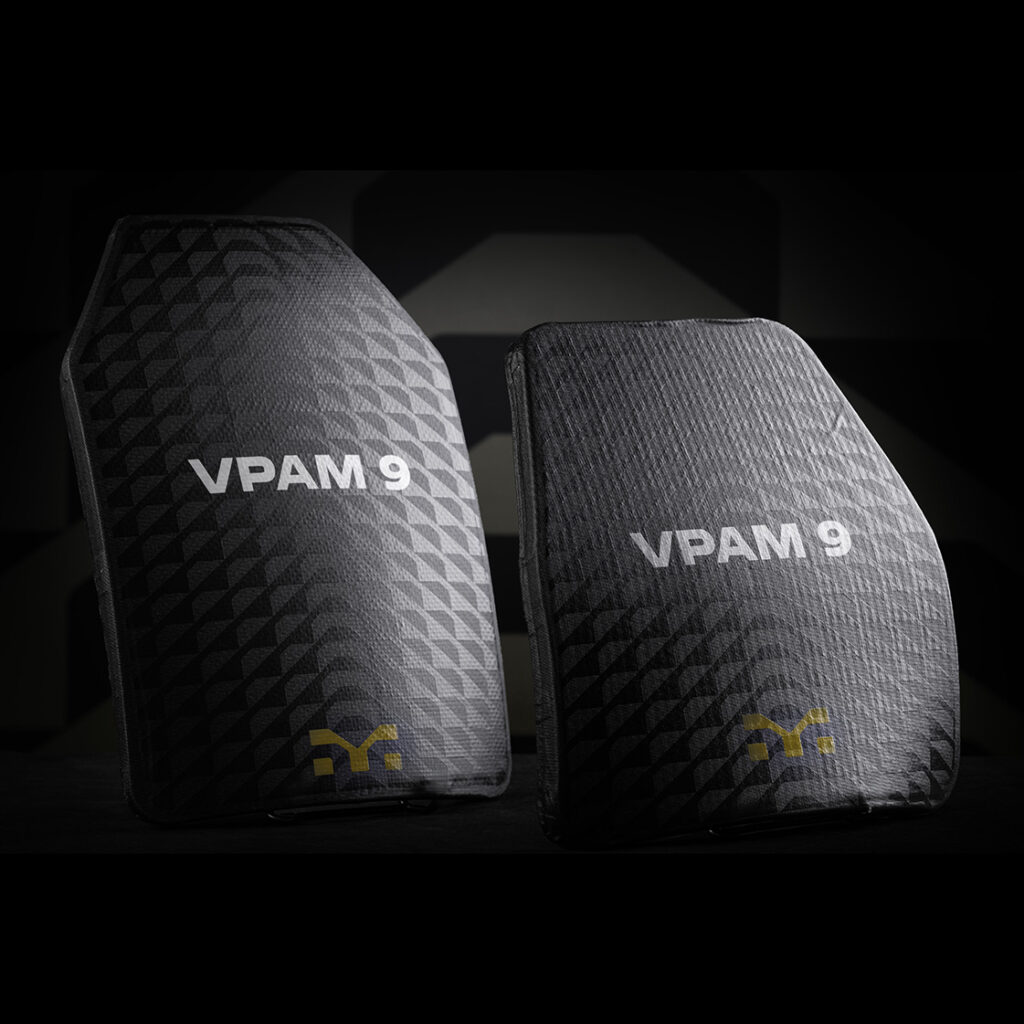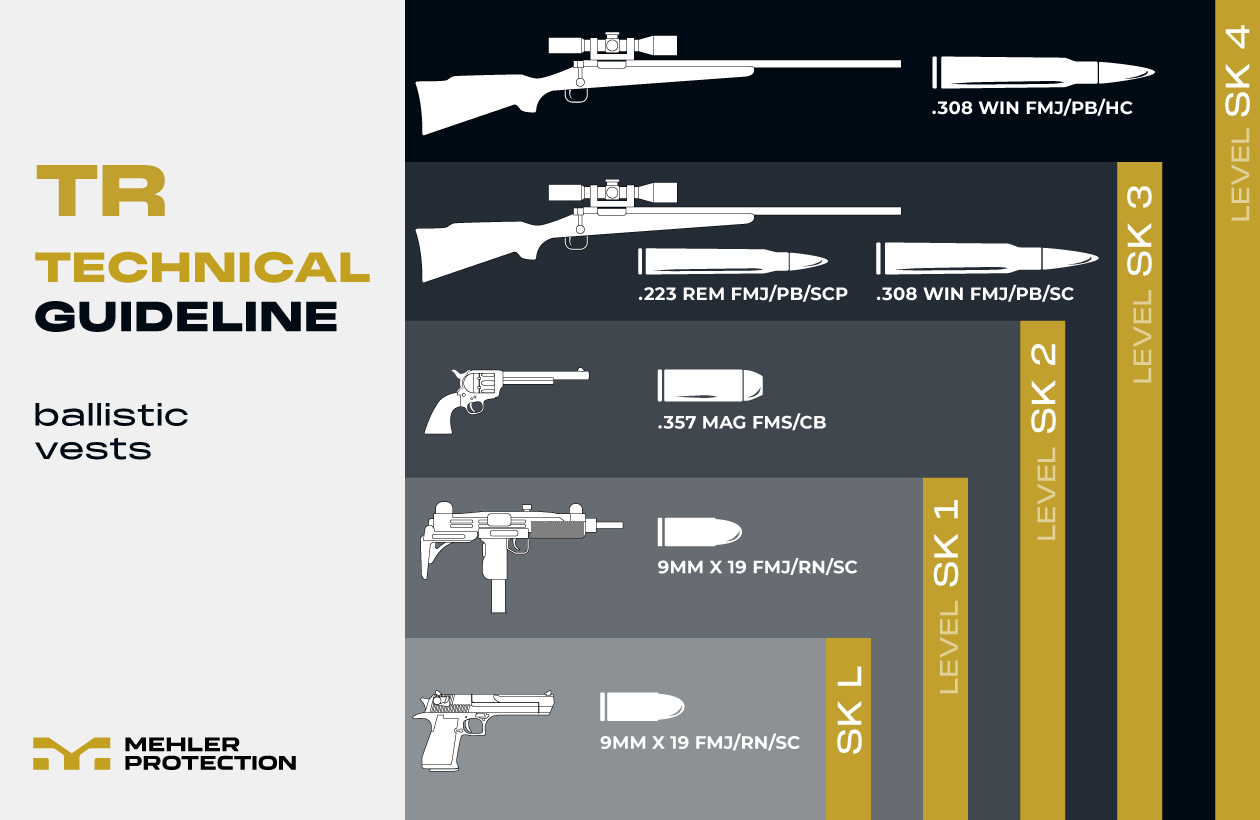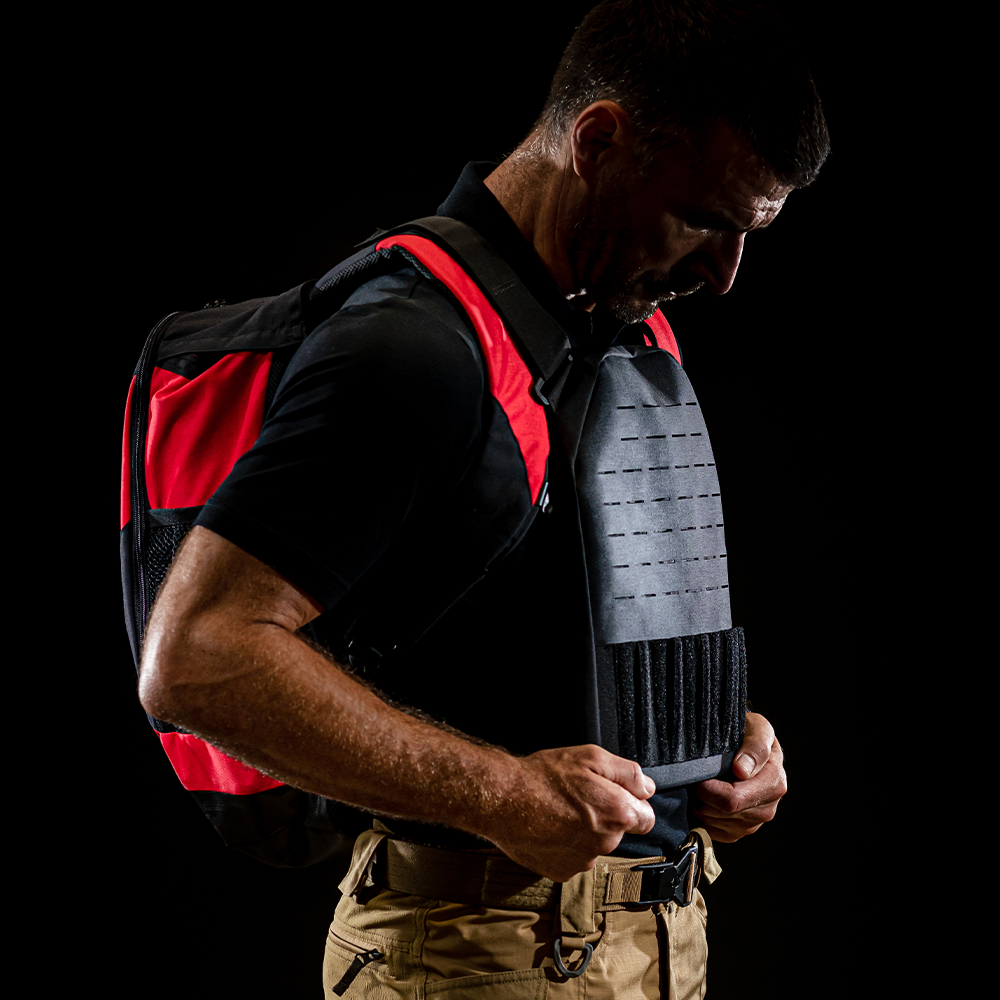
Ballistic protection levels explained - TR
In Germany, the Technische Richtlinie (Technical Guideline, or TR for short) is the leading standard for testing protective vests. This blog post describes the TR’s ballistic requirements for protective vests and the various protection classes into which the TR places them.
Explained are the specifics of the guideline, the testing procedures it mandates, and the protection classes it creates. Included is a comparison of the TR to its American counterpart, the NIJ standard.
Technical guideline (TR) - definition and requirements
The Technische Richtlinie (Technical Guideline, or simply TR), is the leading German standard for testing ballistic protective vests and vests offering stab protection. Implemented in 2008, the guideline creates various protection classes, defines the ballistic requirements of each, and specifies the methods that may be used for testing.
According to the TR, a protective vest should protect the wearer’s upper body—and upper body only—from severe injuries. Such a vest qualifies as ballistic protection if it is bullet- and/or stab-resistant, does not lose its protective effect when exposed to very hot and very cold weather extremes as well as very high humidity, and—at worst—only slightly impedes the wearer’s freedom of movement.
The TR requires that samples of the vest undergoing evaluation be subjected to wear and climatisation testing.
In climatisation testing, the vest’s inserts are sealed within a special cabinet for 16 hours. During that time, the temperature inside the cabinet is lowered to -20°C, then raised to +20°C before finally being bumped up to +70°C with 65-percent humidity. From start to finish, the vest is kept in either a standing or hanging position.
In wear testing, the material processing and resistance performance of the vest is assessed. This is accomplished by removing the inserts from their moisture-absorbing cover and returning them to the special cabinet for another 16 hours, during which time the interior temperature rises to +40°C with 90- to 95-percent humidity.
The TR also prescribes overt and covert vest trauma values. For a covert vest, the maximum trauma value is 40 millimetres, while for an overt vest it is only 22 millimetres (the explanation for this difference is that the overt vest—unlike the covert one—must ensure the readiness of the wearer even after the hit.
Ballistic protection classes according to the TR (SK L to SK 4)
Listed within the TR for ballistic protective vests are five classes of protection: SK L, SK 1, SK 2, SK 3, and SK 4 (of these, the most common are SK 1, SK 2, and SK 4).

The classes differ on the basis of ammunition types and threat levels protected against. For example, a vest would be rated protection class SK L if it stops projectiles fired from common handguns1; that same vest would be rated protection class 1 (SK 1) if it stops projectiles from submachine guns2.
Meanwhile, a vest earning a protection class 2 (SK 2) rating does so if it stops all handgun projectiles3, a protection class 3 (SK 3) rating if it stops standard projectiles fired from long guns4, and a protection class 4 (SK 4) rating if it stops hard-core projectiles from long guns5.
SK L and SK 1 testing involve striking the vest with a volley of four shots fired at a 0-degree angle, three shots fired at a 65-degree angle, and three “point blank” shots fired at a 0-degree angle. SK 2, SK 3, and SK 4 testing involve three shots fired at a 0-degree angle and three shots fired at a 65-degree angle.
- Protection class SK L: 9x19mm bullet size, FMJ/RN/SC bullet type, 360 m/s ± 10 m/s impact velocity.
- Protection class 1 (SK 1): 9x19mm bullet size, FMJ/RN/SC bullet type, 415 m/s ± 10 m/s impact velocity.
- Protection class 2 (SK 2): 357 calibre (magnum) bullet size, FMs/CB bullet type, 580 m/s ± 10 m/s impact velocity.
- Protection Class 3 (SK 3): .223 calibre (Remington) and .308 calibre (Winchester) bullet sizes, FMJ/PB/SCP and FMJ/PB/SC bullet type, 950 m/s ± 10 m/s & 830 m/s ± 10 m/s impact velocity.
- Protection Class 4 (SK 4): .308 calibre (Winchester) bullet size, FMJ/PB/HC bullet type, 820 m/s ± 10 m/s impact velocity.
The firing distance for a mounted bombardment of protection classes SKL, SK 1, and SK 2 is 5 metres; 10 metres for protection classes SK 3 and SK 4.
Stab protection can be added in each protection class. Testing for impingement is always conducted with a separate insert for each of the assessed impingement angles.
However, a vest that qualifies for, say, an SK 1 rating cannot be designated an SK 3 by also passing the test for an SK 2—it would have to separately undergo and pass the SK 3 test to earn that rating. In other words, SK 1 plus SK 2 does not equal SK 3.
Protection classes SK 1+ and SK 4+
Level NIJ IIA is a minimum standard for bulletproof vests. It is often the standard applied in the production of soft body armour made up of layers of high-strength fibres. Examples of these fibres include para-aramid (Kevlar, Twaron) and high-performance polyethylene (Spectra, Dyneema)—for more information about these two bullet-resistant materials, please read our previous blog article.
Calibres not included in protection classes 1 through 4 are often assigned to protection class “SK1+” or “SK 4+.” These are not officially TR-recognised protection class divisions for protective vests. Consequently, they are accorded a different interpretation. Typically, “SK1+” is understood as 7.62 x 25 VMR/WK (Tokarev) with 5.5 g and a velocity of 500 +-20 m/sec. The Tokarev hard core (iron core), on the other hand, is very difficult to stop using a flexible assembly as basic protection.
In most cases, protection class “SK4+” is spoken of when the ammunition is 7.62 x 54 R VMS/HK-Brand B32. The velocity, according to VPAM class 10, is given as 860 +-10 m/sec. Based on experience, however, a single shot of this calibre would already be stopped with a high-quality SK 4 plate (assuming the plate design was in keeping with the TR-specified requirements for triple-plate firing).
Also very often associated with “SK4+” is the tungsten carbide core 7.62 x 51 VMS/HK (e.g., Bofors’ 7.62 x 51 VMS/HK FFV APHC). Stopping this bullet requires an extremely hard and difficult-to-deform core, which necessitates a relatively strong superstructure of special high-performance ceramics.
TR vs. NIJ - how are they different?
Germany’s Technical Guideline (TR) and America’s National Institute of Justice (NIJ) Guideline differ in three primary ways. First, they don’t employ the same testing methods. Second, each has its own framing of protection class divisions. Third, they diverge in choice of bullet size and type.
Unlike the U.S. guideline, the German guideline requires testing with a point-blank shot fired from a weapon pressed with a 100-N force against the specimen. Also, the German guideline calls for firing at an angle of 25 degrees, whereas the U.S. guideline spells out angles of 45 and 60 degrees. Another difference is that the TR requires wet tests at a distance of 0 metres for protection classes SK L and SK 1; NIJ has no similar requirement. Absent from the NIJ guideline is the TR testing requirement to condition the protective packages at -20°C and +70°C.
As well, the two guidelines diverge with regard to projectiles to be used: for example, TR’s protection class 1 rating is comparable to NIJ’s Level IIIA rating, but only the U.S. guideline requires that a shot from a .44 magnum be included in the testing for that degree of protection.
Even though both the TR and NIJ standards test with a 9mm bullet, the TR-prescribed DM41SR is unquestionably a more aggressive 9mm than the one specified by the NIJ (owing to the DM41SR’s steel jacket). Yet another divergence of note: under German guidelines, the protective insert is subjected to a three-shot test, whereas the U.S. guidelines mandate but a single shot—and with bullets that exhibit behaviours dissimilar to those used in TR-specified testing.
The differences do not end there. Protective vests developed and tested in accordance with Germany’s TR guideline are customarily sealed with a moisture- and water-repellent cover, although no test for waterproofness is required (as is the case for vests seeking an NIJ rating). Meanwhile, vests built to comply with the TR guidelines must include a warranty that runs a minimum of 10 years; that requirement is not found in the NIJ standard. Last but not least, the TR articulates no standardised stab protection tests, but the NIJ does.
Summary
Germany’s Technical Guideline addresses more threat scenarios than do other guidelines. This, plus requirements for testing with point-blank shots and (police) special bullets, have helped make the TR the leading standard in Germany for gauging and assuring the performance of protective vests.
The TR outlines five protection classes of ballistic vests (SK L, SK 1, SK 2, SK 3, and SK 4—bullet-resistant) and five protection classes of vests with stab protection (SK L ST, SK 1 ST, SK 2 ST, SK 3 ST, and SK 4 ST—bullet- and stab-resistant). Which class a vest falls into depends on the type of ammunition and threat level it is capable of protecting against, a distinction determined by the tests specified in the TR. It is not unusual for those calibres not included in protection classes 1 to 4 to be assigned to the non-existent—and differently interpreted—protection class “SK1+” or “SK 4+.”
The TR is often compared to the U.S. guideline (NIJ), although they differ greatly in terms of test methods, bullet types, and protection classes. For example, according to the TR, all test samples are subjected to wear and climatic tests, but no puncture protection tests as in the NIJ. Thanks to the TR’s elaborate testing procedures and demand for providing a minimum 10-year warranty, purchasers and users of protective vests developed in Germany are assured of these product’s durability and robustness.

